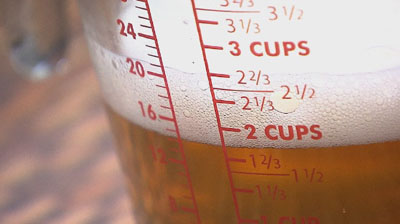Blog
Under Fire for Causing Diabetes, Coca-Cola Pivots to Cirrhosis
- Details
- Created: Friday, October 16 2020 00:08
 It’s lonely at the top of the mountain. Perhaps this explains why the Coca-Cola company has launched alcoholic Topochico, a spinoff of the popular Mexican sparkling water brand. After all, when their coalition of soda and alcohol companies successfully forced California legislature to ban all soda taxes, they defended their right to make money off damaging the pancreas of millions. Why not move on to the liver? Even better, why not move on to the livers of the Latinx community, a group who historically drinks at a lower rate than the U.S. average?
It’s lonely at the top of the mountain. Perhaps this explains why the Coca-Cola company has launched alcoholic Topochico, a spinoff of the popular Mexican sparkling water brand. After all, when their coalition of soda and alcohol companies successfully forced California legislature to ban all soda taxes, they defended their right to make money off damaging the pancreas of millions. Why not move on to the liver? Even better, why not move on to the livers of the Latinx community, a group who historically drinks at a lower rate than the U.S. average?
Alcoholic Topochico is already available in Mexico and Brazil, and is coming to the United States early next year. The product is manipulative and threatening in two ways:
- As the namesake of a popular non-alcoholic Mexican product, it targets the Latinx community.
- As a massive global company with abilities to forge policies in any country it chooses, alcoholic Topochico immediately makes Coca-Cola the new player among Big Alcohol.
The first is a major area of concern, especially among community advocates who have been following the exploitation of Latinx individuals by the alcohol industry. “Coke has continued to market Latinx culture and tradition,” said Mayra Jimenez, Advocacy Manager for the California Alcohol Policy Alliance, “profiting from increases in obesity and decreases in quality of life … The latest iteration of Topochico is a continuation of its policy of proliferating at all costs, even the lives of Latinos.”
Jimenez noted that the Mexican state of Oaxaca has already begun moving to ban the sale of Coca-Cola products to minors. This, combined with the fact that the Latinx and Hispanic population has historically drank less than the White population, suggests that Coca-Cola has motivation to try and get every penny it can from them. According to the Wall Street Journal, the Latinx population is young, growing, and in every alcohol company’s crosshairs.
And Coca-Cola has demonstrated the ability to not just choose a target, but shoot to kill. The company brought in nearly $32 billion, and is easily the largest soda company in the United States and the world, nearly doubling the market share of its nearest competitor. By entering the alcohol space, it is primed to use its economic and political clout to continue the destruction of global alcohol controls. Moreover, with truly globe-spanning brand recognition, it could give AB InBev a run for its money in breaking into new markets that currently consume little commercial alcohol.
To Jimenez, however, the harm is all part of the same pattern. “Coke has done nothing but profit from poverty while appropriating Latino culture, and it’s at it again.”
READ MORE about the how alcohol hurts racial and ethnic minority communities.
READ MORE about how Big Alcohol runs roughshod over low-income Mexican communities.
Friday 11/20: LAST DAY of the CAPA Virtual Summit
- Details
- Created: Wednesday, October 28 2020 23:18
 UPDATE: Over the past two Fridays, CAPA is proud to have brought together public health officials, community advocates, and representatives from across the spectrum of California experience. November 20, 2020, is the final day of the CAPA 2020 Virtual Summit. The final day boasts poets, power-building, and a celebration of the work we've all done to resist the power of Big Alcohol.
UPDATE: Over the past two Fridays, CAPA is proud to have brought together public health officials, community advocates, and representatives from across the spectrum of California experience. November 20, 2020, is the final day of the CAPA 2020 Virtual Summit. The final day boasts poets, power-building, and a celebration of the work we've all done to resist the power of Big Alcohol.VIDEO PREVIEW ♦ DAY 3 SCHEDULE ♦ REGISTER HERE
Alcohol harms are social justice issues. In 2020 we have seen vulnerability, oppression, and exploitation be the catalyst for powerful social justice movements. Public health has a role to play in these movements, and we cannot understand what that is without understanding the intersections of who we are, what we experience, and forces running through society. The fifth annual California Alcohol Policy Alliance (CAPA) Summit focuses on bringing together diverse voices to speak out against disproportionate harms and abuses perpetrated by Big Alcohol and consider innovative strategies for the future.
Government Cuts Safe Drinking Levels For Men In Half
- Details
- Created: Friday, August 07 2020 18:46
 How much difference does a single drink make? Enough to save lives, according to preliminary dietary guidelines published by the United States Departments of Agriculture (USDA) and Health and Human Services (HHS). The guidelines take the small yet revolutionary step of lowering the recommended maximum drinks per day for men from two to one.
How much difference does a single drink make? Enough to save lives, according to preliminary dietary guidelines published by the United States Departments of Agriculture (USDA) and Health and Human Services (HHS). The guidelines take the small yet revolutionary step of lowering the recommended maximum drinks per day for men from two to one.
“The observational evidence base with respect to alcohol consumption is insufficient to recommend drinking at any level,” the team writes. In particular, they note problems with the research connecting two drinks a day for men to avoidance of cardiovascular outcomes, as well as a growing body of research connecting alcohol use to cancer risk. They cite recent studies that try to remove some of the bias in historical evaluations of alcohol risk, which, in aggregate, suggest men who drink 1 to 1.5 drinks a day are at less risk than those who adhered to the old standard of two.
“For decades we’ve taken flawed studies with easily identified sources of bias,” said Carson Benowitz-Fredericks, MSPH, research manager for Alcohol Justice, “and made firm conclusions based on them. What we’re seeing now is hardly a revolution, it’s just the government catching up with the state of the science.”
While the reduction in recommended drinks per day seemed nominal, it has raised the ire of the alcohol industry. Speaking to the Santa Rosa Press-Democrat, Rob McMillan, executive vice president of Silicon Valley Bank’s wine division, lamented that the guidelines were “one more piece of ammunition to those who are anti-alcohol.” In the same article, R. Curtis Ellison, M.D., a researcher with a history of receiving alcohol industry funding, invoked the Trump Administration’s signature dismissal of unfavorable reports, calling the report “fake news.”
This is a remarkable turnabout for an industry accustomed to finding HHS amenable to its interests. As recently as 2018, Anheuser-Busch InBev had convinced the National Institutes of Alcohol Abuse and Alcoholism to allow them to fund a trial on the “health benefits” of alcohol consumption. The trial, called MACH-15, was led by a researcher who cleared every step of the protocol with representatives of the mega-brewer, and who promised them that the results could be used to convince doctors to prescribe.
“The alcohol industry took for granted that they had federal consultants under their thumb,” said Michael Scippa, public relations director for Alcohol Justice, “and they’re going to try and fight this. We need to be louder, and send a message to Washington that these revised guidelines are smart, scientific, and long overdue.”
The comment period for the revised guidelines stays open until Augst 13, 2020. Alcohol Justice strongly supports these guidelines.
TAKE ACTION to voice support for lowering the safe alcohol consumption levels.
READ MORE about corruption in government alcohol research
READ MORE about the myth of healthy drinking.
READ MORE about Big Alcohol’s French Paradox fraud.
More Articles ...
Subcategories
Help us hold Big Alcohol accountable for the harm its products cause.
| GET ACTION ALERTS AND eNEWS |
STAY CONNECTED    |
CONTACT US 24 Belvedere St. San Rafael, CA 94901 415-456-5692 |
SUPPORT US Terms of Service & Privacy Policy |


